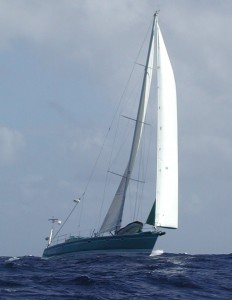 I used epigraphs for each of my chapters in Voice of a Voyage: Rediscovering the World During a Ten-year Circumnavigation. In Chapter 3, “The Longest Passage: What It Means to Travel” I quote Edward Hoagland in his essay, “Heading Out from Home,” from The Tugman’s Passage,” To live is to see, and traveling sometimes speeds up the process.” Hoagland, by the way, if you’re not familiar with his writing, is a brilliant essayist, particularly of travel and nature writing, and also a novelist of distinction. Hoagland is writing of what we see as in understand, contemplate, wonder about—senses requiring more than our eyes. In terms of this voyage, seeing in the literal sense was quite important during passages, but became an essential element in Hoagland’s broader sense also. How many trips are formed by the journey, even more than the destination? The photo is of our yacht, S/V Bali Ha’i III underway between the Galapagos and the Marquesas, French Polynesia, taken by the crew of S/V Reflections as we passed in mid-ocean, later to share our photos of each other’s boats underway. A view we rarely get!
I used epigraphs for each of my chapters in Voice of a Voyage: Rediscovering the World During a Ten-year Circumnavigation. In Chapter 3, “The Longest Passage: What It Means to Travel” I quote Edward Hoagland in his essay, “Heading Out from Home,” from The Tugman’s Passage,” To live is to see, and traveling sometimes speeds up the process.” Hoagland, by the way, if you’re not familiar with his writing, is a brilliant essayist, particularly of travel and nature writing, and also a novelist of distinction. Hoagland is writing of what we see as in understand, contemplate, wonder about—senses requiring more than our eyes. In terms of this voyage, seeing in the literal sense was quite important during passages, but became an essential element in Hoagland’s broader sense also. How many trips are formed by the journey, even more than the destination? The photo is of our yacht, S/V Bali Ha’i III underway between the Galapagos and the Marquesas, French Polynesia, taken by the crew of S/V Reflections as we passed in mid-ocean, later to share our photos of each other’s boats underway. A view we rarely get!
Here is an excerpt from this chapter.
There is the transitory nature of travel from one point to another, but there is also the aspect of the actual journey being an entity in and of itself. Going from one place to another has its own magic, its own life, its own meaning. The metaphor for life itself is a journey from birth to death. There is something both physical and metaphysical in a journey. This process, this time, this movable space we took up as we sailed on became for me a place of its own.
This time on a sailboat alone at sea, out of sight of land for days on end—I wondered how it would shape me and the space through which I traveled? What path can endure when all that is left is the yacht’s wake melting into the waves and the swell of the ocean behind?
